Check, Billfold, & Wallet Calculators
The calculators on this page are specifically intended to be carried in the pocket and some can maintain a balance of money.
Their names reflect this by incorporating "Check" (Cheque in the U.K.) or "Billfold" (Wallet in the
U.K.), and for their year of manufacture they are especially slim so that they do not leave a bulge in the pocket.
The calculators featured on this page are:
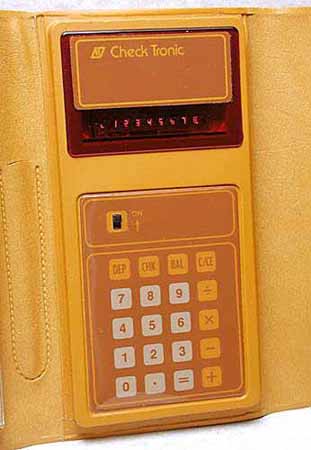

Check Tronic
Distinctive features: Cheque (check) account calculator. Balance still stored when switched off.
Technical details:
Display is 8 digits, red LED.
4-function.
A standard 4-function calculator incorporated in a wallet for balancing a bank cheque (check) account.
Unusually for this early date, the balance is stored even when the calculator is switched off, and can be recalled when
switched on again. This is achieved by maintaining power to at least the memory.
9v (PP3 battery).
About 1975.
The logo 'AD' indicates that this model is from Arizona Digital Corporation of Phoenix, Arizona, U.S.A.
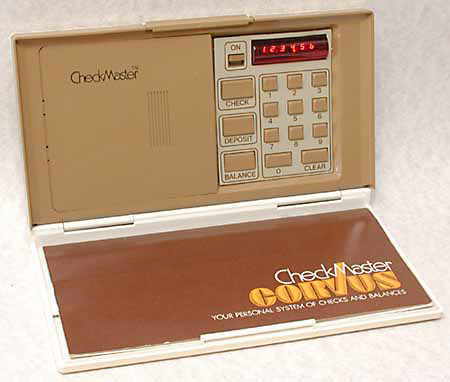
Corvus/Mostek CheckMaster
Distinctive features: Very basic cheque (check) account calculator. Only has "+" and "-" functions. Balance still stored when switched off.
Technical details:
Display is 6 digits, red LED.
2-function.
This is a very basic calculator in a folding case for balancing a bank cheque (check) account. The display has a fixed decimal point for currency calculations, there is no decimal point key, and the only functions that provided are
"Deposit" (add) and "Check" (subtract).
Like the Check Tronic above, the balance is stored even when the calculator is switched off, and can be recalled when next switched on. Again this is achieved by maintaining power to at least the memory.
9v (6x AAA batteries).
Made by Corvus Corporation, of Dallas, Texas, a subsidiary of Mostek, the Semiconductor manufacturer.
In June 1975 JS&A National Sales Group was selling this model at the "introductory price" of US$39.95[1].
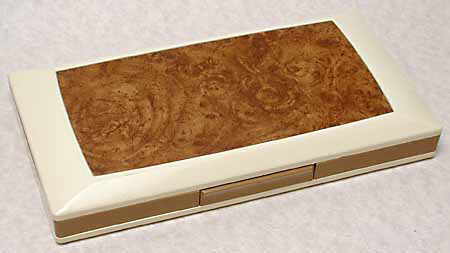
The Corvus CheckMaster closed.
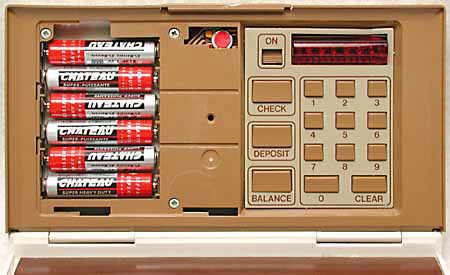
With the battery cover removed, showing the 6x AAA batteries.
The journal 'Electronics', for April 3, 1975, reported the introduction of the CheckMaster[2]:
"The Mostek machine, unveiled this week, is a
checkbook calculator that will hold and display a user's checking-account balance for a year, using a single set of batteries.
Mostek's CheckMaster offers proof that the company can make p-channel MOS devices
that dissipate almost as little power as complementary MOS. The $39.95 unit is a two-function machine with memory. The checking-account balance is maintained continuously in the memory and is displayed when the
"balance" key is depressed and triggers the memory-recall function. Adding to and subtracting from memory is handled with "deposit" and "check" buttons; Mostek has used what is essentially reverse Polish notation to eliminate
the "equals" key.
Low-drain memory. Key to the design of the chip is a gated-clock, static shift-register memory that draws less than 25 microamperes when
the calculator is off. "We went to a static shift register to eliminate much of the timing circuitry that is superfluous to storing data," comments Robert C. Farrier, designer of the chip.
"We use an
extra gate to connect the output of each flip-flop in the shift register back to its input, so it looks like a cross-coupled latch as opposed to a two-phase clocked flip-flop," he says. The memory is clocked only when it is
being accessed.
In addition to minimising the amount of logic the memory requires, Farrier used very long depletion loads to reduce the power drain in the power-up mode. "Within that register, we had to
make sure that no one device drew too much power," he says. Of about 500 loads in the circuit, only about 50 are unswitched, and ion-implantation gives each of those as high a resistance and as low a power consumption as is
consistent with the circuit's speed requirements.
As a result, the chip needs less than 1.5 milliamperes even when the calculator is on. ChackMaster operates from six 1.5-v AAA alkaline batteries."
This model was also reviewed in Popular Science[3]:
"Electronic Checkbook remembers your balance
When l
tapped an imaginary checking-account balance into Mostek Corp.'s new CheckMaster, I was amazed to learn the electronic checkbook would remember the dollars-and-cents figures for up to one year. Six penlight cells power
the unit's low-current memory. As you write checks or make deposits, you perform arithmetic with CHECK, DEPOSIT, and BALANCE keys. And CheckMaster shows the overdraft amount, if any. (Jot down your balance and
you can also use CheckMaster as an add-subtract calculator).
bur.) The $40 eight-ounce unit is 7/8 by 3 5/8 x 6 3/4 inches. Distributor is JS&A National Sales Group, 4200 Dundee Rd., Northbrook, Ill. 60062."
It is interesting to note that Mostek, the parent company of Corvus, had largely exited the calculator market a few months after the launch of the CheckMaster due to making large losses, but retained just that model[4]. "Rights to manufacture the calculator line, and to market under the Corvus label, went to Colex Ltd., Hong Kong", a long-time chip customer. Mostek retained the digital clocks as well as a checkbook calculator, products it will market under the Mostek brand name."
The Check Tronic and Corvus CheckMaster calculators above have the unusual feature, for this early date, of storing a number when the calculator is switched off. This is achieved by maintaining power to, at least, the memory and requires the very low power consumption possible using C-MOS (Complementary Metal Oxide Semiconductor) integrated circuits. However, if the batteries are removed the number is lost.
The Corvus CheckMaster is probably the least capable electronic calculator ever marketed, since it is only capable of addition and subtraction, though this is all that is required for its design purpose.
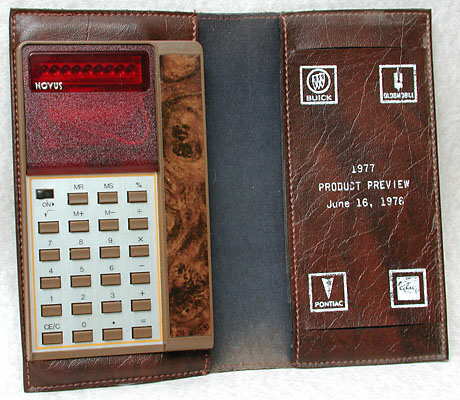
Novus Billfold 91
Distinctive features: Cheque (check) account calculator. Takes unusual Flat-Pak battery.
Technical details:
Display is 8 digits, red LED.
4-functions, %, memory, square-root.
This is a really just a slim calculator incorporated in a billfold (wallet), and, unlike the Check Tronic and Corvus CheckMaster calculators above, it does not retain memory when the power is switched off.
9v special Duracell "Flat Pak" battery.
This example appears to be a promotional item for the preview of the 1977 range of Buick, Oldsmobile, Pontiac, and GMC motor vehicles, which was held on June 16, 1976.
Made by in U.S.A. by National Semiconductor.
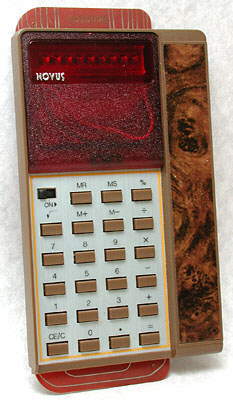
The calculator is unusual in that it is held in the billfold by extensions of its circuit board which pass through slots in the synthetic leather.
The calculator must be removed from the billfold to replace the battery.
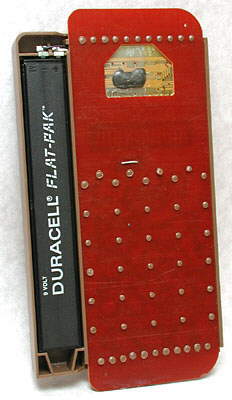
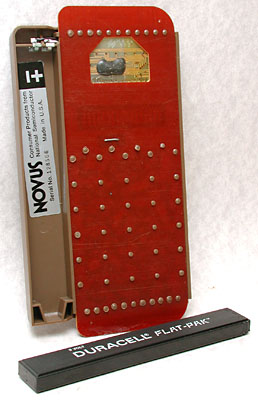
The battery used in the calculator is a very unusual 9 volt Duracell "Flat-Pak".
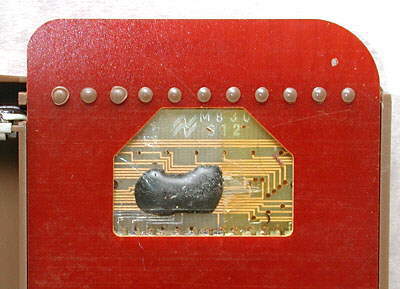
The semiconductor chip used in this calculator is directly mounted on the circuit board and then encapsulated in a blob of resin for protection. This reduced the cost but was very unusual for the
time, though is now very common.
National Semicinductor also used this technique in its Novus 650 "Mathbox" calculator.
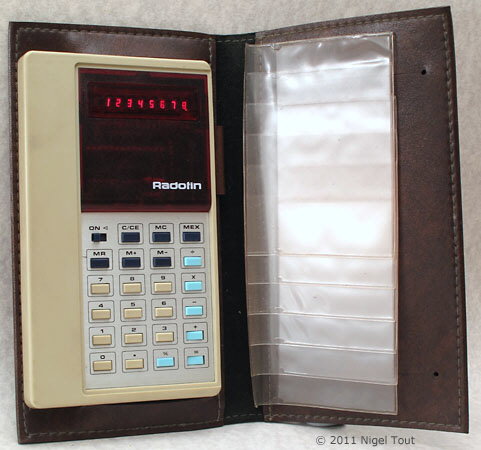
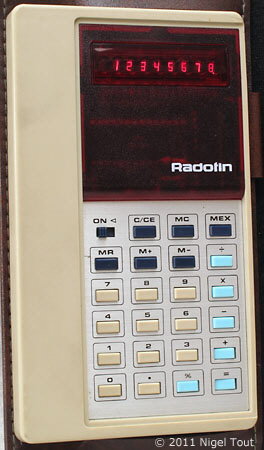
Radofin 1720
Distinctive features: Cheque (check) account calculator.
Technical details:
Display is 8 digits, red LED.
4-functions, %, memory.
This calculator is similar to the Novus Billfold 91, above. Again it is a really just a slim calculator incorporated in a billfold (wallet), and, unlike the Check Tronic and Corvus CheckMaster calculators above, it does not retain memory when the power is switched off.
85 x 170 x 12 mm / 3.3 x 6.7 x 0.5" (calculator only).
6-off AAA batteries.
Radofin Electronics Ltd.
Hong Kong
References:
Hand-held Calculators
Vintage Calculators
Text & photographs copyright, except where stated otherwise, © Nigel Tout 2000-2026.